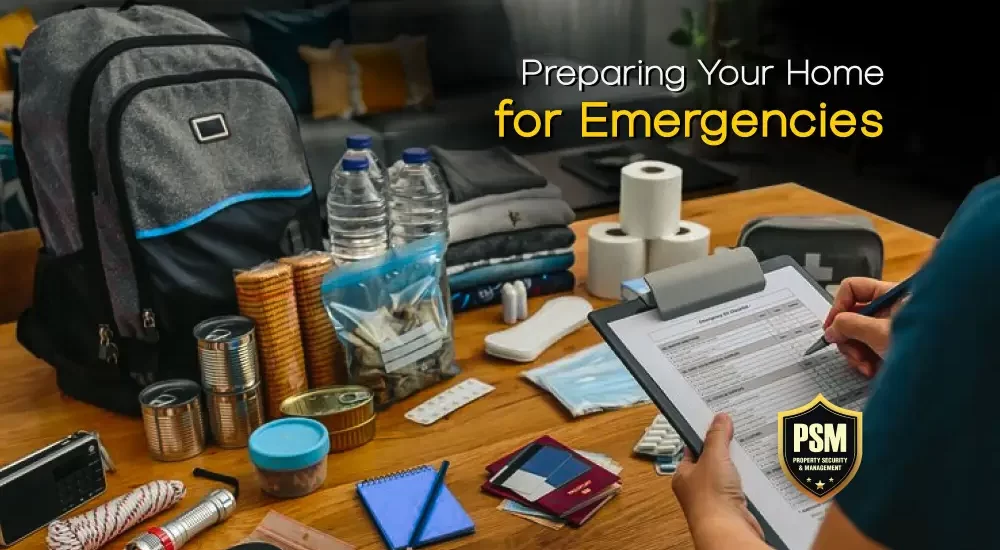- August 3, 2024
- Posted by: Anita Zeba Bakhtiar
- Category: Tips

No matter where you may live; an emergency can befall you at any time, and being prepared can make all the difference when protecting your family and home. Whether it’s a natural disaster, a power outage, or a sudden medical emergency, having a plan in place can help you handle such situations with confidence. Here’s a comprehensive guide to preparing your home for emergencies:
1. Create an Emergency Plan
Family Meeting: Sit down with your family and discuss potential emergencies that could affect your area, such as hurricanes, earthquakes, or severe storms. Develop a plan that outlines what each person should do in various scenarios.
Escape Routes: Identify and practice multiple escape routes from your home. Ensure everyone knows how to get out quickly and safely.
Meeting Points: Choose a safe meeting place outside your home where everyone can gather if you need to evacuate.
Communication: Set up a communication plan that includes how you will contact each other (if separated) and how you will receive emergency alerts and updates.
2. Assemble an Emergency Kit
Basic Supplies: Gather essential items and store them in an easily accessible location. Your emergency kit should include:
- Non-perishable food (3-day supply per person)
- Water (one gallon per person per day for at least three days)
- Battery-powered or hand-crank radio
- Flashlight and extra batteries
- First aid kit
- Personal hygiene items (toilet paper, sanitary supplies, etc.)
- Tools and supplies for securing your home
- Important documents (identification, insurance policies, medical records)
- Cash and coins
- Blankets and warm clothing
Special Needs: Don’t forget to include items for infants, elderly family members, or pets, such as baby formula, medications, and pet food.
3. Secure Your Home
Structural Integrity: Ensure your home is structurally sound. Reinforce weak points such as windows and doors, and secure heavy furniture and appliances to prevent them from tipping over during an earthquake.
Fire Safety: Install smoke detectors on every level of your home and test them monthly. Keep fire extinguishers in key areas, such as the kitchen and garage, and make sure everyone knows how to use them.
Flood Protection: If you live in a flood-prone area, consider purchasing sandbags or other barriers to protect your home from water damage.
Emergency Contacts: Keep a list of important phone numbers (emergency services, doctors, insurance agents) in a visible and accessible location.
4. Prepare for Power Outages
Backup Power: Invest in a generator or backup battery system to keep essential appliances running during a power outage. Be sure to follow safety guidelines for generator use.
Alternative Light Sources: Stock up on candles, lanterns, or solar-powered lights. Have a way to charge your electronic devices in case of a long-term outage.
Food Storage: Ensure your refrigerator and freezer are well-stocked and understand how long food will remain safe without power.
5. Plan for Medical Emergencies
First Aid Training: Consider taking a first aid and CPR course to be prepared for medical emergencies.
Medication: Keep a supply of essential medications and first aid supplies. Store prescription medications in a waterproof container.
Medical Information: Maintain a list of medical conditions, allergies, and emergency contacts for each family member. Keep this information in your emergency kit and update it regularly.
6. Stay Informed
Emergency Alerts: Sign up for local emergency alerts and notifications. Stay informed about potential threats and weather conditions.
Community Resources: Know your community’s emergency resources, such as local shelters, medical facilities, and emergency services. Familiarize yourself with the procedures and locations of these resources.
7. Practice Regular Drills
Drills: Regularly practice your emergency plan and evacuation routes with your family. This helps everyone become familiar with the procedures and reduces panic during an actual emergency.
Review and Update: Periodically review and update your emergency plan and kit. Adjust as needed based on changes in your family’s needs or living situation.
By taking these proactive steps, you can significantly improve your family’s safety and readiness in emergencies. The goal is to be prepared under all possible circumstances. Stay safe and be prepared!
